|
Displaying items by tag: Renovation

The Speed Art Museum in Louisville, KY announced that it has exceeded its $50 million fundraising goal for its Changing Speed expansion and renovation project by $334,000. The campaign’s success will allow the museum to complete Phase I and II of its plan, which includes building a new North Building, a central utilities building, and an art park and piazza.
The New North Building will span 62,500-square-feet and will double the museum’s overall physical space. The state-of-the-art renovation will include larger spaces for special exhibitions, contemporary art galleries, a family education welcome center, indoor and outdoor cafes, a museum shop, and a multifunctional pavilion for lectures and performances.
A major family gift made by civic leader Christy Brown will allow the Speed Art Museum to complete Phase III of its plan, which includes building a new South Building and extensive renovations to the existing structure. Brown made an $18 million contribution to the project in honor of her late husband, Owsley Brown II. The new 9,500-square-foot South Building will include additional gallery space and a state-of-the-art theater that will be capable of showing 16mm and 35mm films. The South Building will also include a renovated 5,600-square-foot gallery in the Speed’s current structure to house the museum’s significant collection of early Kentucky fine and decorative arts, which includes paintings, sculptures, furniture, silver, and other objects.
Work on Phase III of the Speed’s plan is underway and Phase I and II are expected to start this summer. All construction and renovations are expected to reach completion by the winter of 2015 and a grand re-opening is slated for early 2016.
Louisville philanthropist Hattie Bishop Speed founded the Speed Art Museum in 1925. It is the oldest, largest, and foremost art museum in Kentucky. The Speed is currently closed for the renovations but a temporary exhibition space was established in downtown Louisville’s Nulu district.
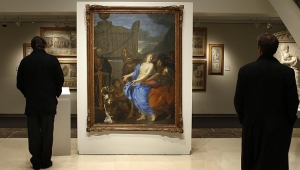
Back in January, a 17th century masterpiece was discovered at Paris’ legendary Ritz hotel, which is currently undergoing a major $267.5 million renovation. Olivier Lefeuvre, a specialist in the period at Christie’s France, first spotted the work, which is by the French painter and court artist of Louis XIV, Charles Le Brun (1619-1690). How the painting ended up in the Ritz remains a mystery, as the hotel archives lack any reference to the work.
The 400-year-old painting was sold by auction house Christie’s on Thursday, April 18, 2013 to New York’s Metropolitan Museum of Art for $1.88 million. The Met does not have any other works by Le Brun so the acquisition will be a welcomed addition to the museum’s collection of 17th century paintings. The masterpiece is expected to go on display at the Met at the end of May.
The painting, which depicts the killing of Trojan princess Polyxena after she was linked to the death of Achilles, had hung in one of the suites at the Ritz that designer Coco Chanel lived in for over 30 years. Proceeds from the sale will go to the foundation established by Ritz owner Mohamed Al Fayed in memory of his son Dodi, the late boyfriend of Princess Diana.

The Metropolitan Museum of Art in New York City will present Diego Velázquez’s (1599-1660) Portrait of Duke Francesco l d’Este, one of the most important portraits by the Spanish painter, through July 16, 2013. The painting is on loan from Italy’s prestigious Galleria Estense in Modena and has never traveled to the United States before. The exhibition, Velázquez’s Portrait of Duke Francesco l d’Este: A Masterpiece from the Galleria Estense, Modena, will coincide with the opening of the Met’s renovated New European Painting Gallery, 1250-1800.
Velázquez, the leading artist in the court of King Philip IV, painted d’Este, the Duke of Modena and Reggio Emilia, while he was visiting Madrid in 1638 to meet with King Philip and ask for his support. The commanding portrait of the 17th century ruler is a key work of baroque portraiture as well as a prime example of Velázquez’s artistic contribution to Spanish diplomacy.
The Galleria Estense acquired the portrait of d’Este in 1843 where it joined works by Tintoretto (1518-1594), El Greco (1541-1614), and Paolo Veronese (1528-1588). The museum also boasts a strong collection of decorative works, musical instruments, archaeological material, and sculptures. The Galleria was damaged in 2012 when a series of earthquakes struck the region of Emilia-Romagna. Restoration of the building has begun but will require years of repair. In the meantime, while many of the museum’s works are being held at the Ducal Palace in Sassuolo, Velázquez’s portrait will make a highly anticipated appearance to New York.

The Board of Trustees of the Corcoran Gallery of Art in Washington, D.C. announced an upcoming partnership with the National Gallery of Art. The three-year agreement allows the Corcoran to exhibit works of modern and contemporary art from the National Gallery’s collection while the museum’s East Building is under renovation. The Corcoran is working on trimming expenses and has been battling rumors that it will sell its landmark Beaux Arts building due to financial troubles. During the Board’s announcement, officials scrapped any speculation by confirming that the Corcoran will not be moving.
The Corcoran has collaborated with the National Gallery in the past but their new partnership is the most expansive to date. Earl A. Powell III, Director of the National Gallery of Art, said, “We are very pleased to be able to share works from the nation’s collection of modern art with visitors to the Corcoran while our East Building is closed for renovations. We have a history of lending works to the Corcoran, but the larger number of works addressed by this agreement and the increased length of their exhibition at the Corcoran makes this a new development in our long relationship.”
The National Gallery of Art is expected to close for renovations beginning next year.
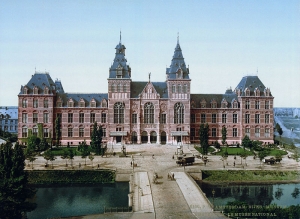
Officials at the Rijksmuseum in Amsterdam announced that the museum will reopen to the public on April 14, 2013. The Rijksmuseum, a Dutch national institution devoted to arts, crafts, and history, has been closed for 10 years as part of a massive renovation and modernization project.
The museum is currently working to reinstall around 8,000 masterpieces from the national collection spanning from the Middle Ages to present day. While the Rijksmuseum’s main building was closed, the institution sent a selection of 400 works, including their most famous painting, Rembrandt’s (1606-1669) The Night Watch (1642), to the Philips Wing, a previously renovated “fragment building” belonging to the museum. The works formed a major exhibition titled Masterpieces of the Dutch Golden Age, which saw approximately 1 million visitors during its run.
The Rijksmuseum renovation cost approximately $481 million to complete and included restoring all eighty of the museum’s galleries with their original decorations and paintings as well as implementing the most up-to-date technologies and applications. The project was expected to reach completion in 2008, but a series of contractor issues and planning problems delayed progress.
Museum officials expect attendance to increase significantly after the institution reopens; prior to the Rijksmuseum’s closure, it saw approximately 1 million visitors each year. The museum is also planning to stay open 365 days a year, which would make it the first national museum in the world to be open every day.
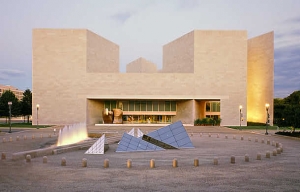
Officials at the National Gallery of Art in Washington, D.C. announced that the museum’s East Building will undergo a $30 million renovation, adding over 12,260-square-feet of exhibition space and a rooftop sculpture garden to the structure. Designed by famed architect I.M. Pei (b. 1917) and opened in 1978, the East Building houses the museum’s collection of modern paintings, drawings, sculptures, and prints as well as study and research centers and offices.
The East Building galleries will gradually close beginning in July and ending in December 2013; they will remain shuttered for approximately three years once renovations begin in January 2014. The project will create two sky-lit Tower Galleries within the East Building, which will be adjoined by an outdoor sculpture terrace. The East Building will continue to house the museum’s modern art collection and may see the addition of a room dedicated to the work of Mark Rothko (1903-1970). Museum officials hope that the additional exhibition space will inspire future donations to the National Gallery’s permanent collection.
The East Building project is part a Master Facilities Plan, which started in the museum’s West Building in 1999 and involved bolstering the building’s infrastructure and renovating its main floor and sculpture galleries. A number of established Washington-based philanthropists are donating $30 million for the East Building project; it is one of the largest gifts the museum has received from private donors in a decade.

Officials at Harvard University in Cambridge, MA announced that they will open the newly renovated and expanded Harvard Art Museums in the fall of 2014. The project, which began in 2008, has entailed a complete reinvention of Harvard’s museum system and will place the Busch-Reisinger Museum, the Arthur M. Sackler Museum, and the Fogg Museum of Art under one state-of-the-art roof.
Renowned architect Renzo Piano was enlisted to transform 32 Quincy Street, the landmark building that currently houses the Fogg and Busch-Reisinger museums, into Harvard’s artistic hub. The new facility will combine the 32 Quincy Street building, which was constructed in 1927, with a new addition and a striking glass rooftop structure that will allow controlled natural light into the facility’s conservation lab, study centers, and galleries. The overhaul also includes a theater for lectures and public programming.
The Arthur M. Sackler Museum, which was established in 1985 in a separate building from the Fogg and Busch-Reisinger, has remained open during the recent construction. The Sackler will close June 1, 2013 to prepare for the relocation of its remarkable Asian art collection to 32 Quincy Street.
The Bush-Reisinger Museum, which was founded in 1903, is the only museum in North America dedicated to the art from the German-speaking countries of Central and Northern Europe. The Fogg Art Museum, which opened to the public in 1896, boasts extensive holdings of American and European art from the Middle Ages to the present.

The Smithsonian Institution in Washington D.C. has announced that its Renwick Gallery, which houses the museum’s American craft and decorative arts collection from the 19th to 21st centuries, will undergo a major renovation. The Renwick Gallery, which opened to the public in 1972, will close to accommodate the project in early 2014 and is expected to reopen in 2016.
Project details are still being worked out and an exact cost for the renovations is yet to be determined. The Smithsonian is planning to use public funds to pay for half of the project and the rest will be paid through private partnerships. The project has already received a $335,000 grant from the National Park Service’s Save America’s Treasures initiative, as the Renwick Gallery is located in a National Historic Landmark building. The building’s construction began in 1859 and went on to house the city’s first art museum, the Corcoran Gallery of Art, upon its completion.
Museum officials plan to convert all of the Renwick Gallery’s lighting to energy efficient LED lights and wireless Internet access will be provided throughout the entire gallery. Heating, plumbing, electrical, air conditioning, and fire safety systems will all be gutted and replaced. This will be the Renwick Gallery’s first renovation in 40 years.
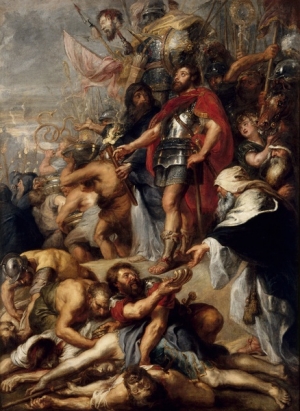
During the French Revolution, which lasted from 1789 to 1799, French troops took Flemish Baroque painter Peter Paul Rubens’ (1577-1640) The Triumph of Judas Maccabeus from the Tournai cathedral in Belgium. The work was whisked away to Paris and in 1801 it was sent to the Musée des Beaux-Arts in Nantes, France.
The Triumph of Judas Maccabeus is one half of a diptych that was commissioned for the cathedral by the bishop of Tournai in 1635. Napoleon’s army stole both The Triumph of Judas Maccabeus and its accompanying work, The Freeing of the Souls from Purgatory, which was returned to the cathedral in 1818.
Tournai officials are adamant about having the Rubens painting returned to the cathedral. Ruby Demotte, president of the French Community of Belgium, has penned a letter to French president Francois Hollande as well as to the French culture minister Aurélie Filippetti asking that the work be sent back to Belgium. Demotte made the same attempt last year but never received a response from the French government.
Tournai recently completed a major renovation of its cathedral and are hoping to finally reunite the two Rubens paintings.
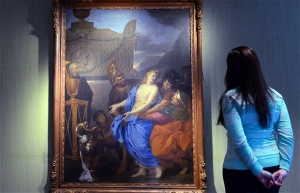
Paris’ legendary Ritz hotel, which is currently undergoing a major $267.5 million renovation, has been unknowingly sheltering a 17th century masterpiece. The work, which is believed to be by the French painter and court artist of Louis XIV, Charles Le Brun (1619-1690), was first spotted by Olivier Lefeuvre, a specialist in the period at Christie’s France. Upon seeing the painting in July, a month before the Ritz closed its doors for two years worth of renovations, Lefeuvre knew that the work had to be a Le Brun. Initials reading “CLBF,” which stands for Charles Le Brun Fecit (Le Brun did this) and a date, “1647,” were found on the work, supporting Lefeuvre’s hunch.
How the painting ended up in the Ritz remains a mystery, as the hotel archives lack any reference to the work. While Christie’s has been unable to track down any record of the painting, officials have no doubt that the work is an authentic Le Brun. The painting, which depicts the killing of Trojan princess Polyxena after she was linked to the death of Achilles, was renamed The Sacrifice of Polyxena by Christie’s.
The Le Brun painting will be auctioned by Christie’s in Paris in April 2013 and could raise as much as $665,000 for the foundation established by owner Mohamed Al Fayed in memory of his son Dodi, the late boyfriend of Princess Diana. Dodi and Diana dined at the Ritz before their fatal car accident in 1997.
The painting will go on display at Christie’s New York location next week.
|
|
|
|
|